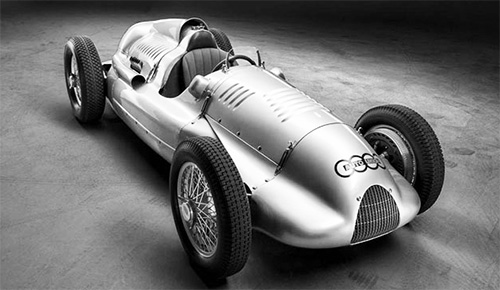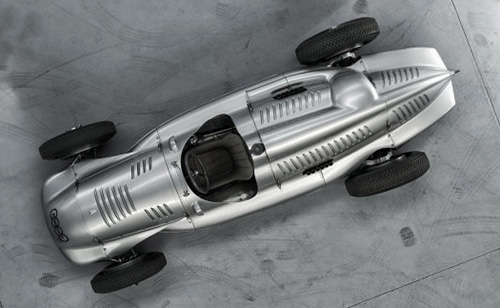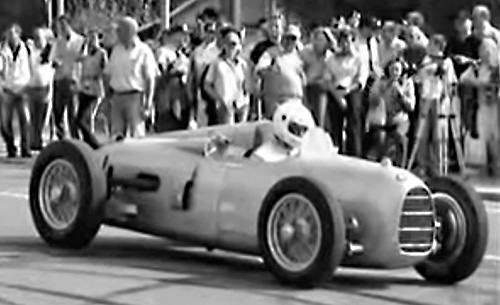AUTO UNION USA.com
AUTO UNION HISTORY
A brilliant idea...
It was early in the third decade of the twentieth century and the European auto market was fragmented with more than a dozen auto manufacturers. The promise of new technologies excited the design teams. Each manufacturer tried to push the envelope with style and performance offerings more advanced than ever.

The problem with these competing companies,though, was how to differentiate their line of products. Four German automobile manufacturers: Audi, DKW, Horch and Wanderer decided to meet and ally to their mutual benefit.

They agreed to form a new amalgamation: Auto Union AG. Founded in 1932 and established in 1936 in Chemnitz, Saxony, during the Great Depression, they embarked upon creating the most powerful and fastest automobiles in the history of their industry. This behemoth was born to incite the marketplace and came to inspire the Golden Age of Grand Prix racing.

AUTO UNION RACING
A stunning presence...
The acid test of any automobile manufacturer's design was the racetrack, and in the early 1930's it was the Grand Prix circuit that exemplified the highest advancement of performance. From 1933 to 1939 Auto Union Type A through Type D cars answered the call for innovation. In 1935 the Auto Union Type C car led the company's domination of the competition in terms of design and power.

It was the introduction of the supercharger and V16 (later modified to V12) engine technologies that brought the speed and excitement to European racing venues with stunning results.

In a city called Zwickau, Germany the legendary Auto Union race cars were conceived and birthed...
From the Wikipedia article:
"Auto Union Chairman, Klaus, Baron von Oertzen, wanted a showpiece project to announce the new brand. At the 1933 Berlin Motor Show, German Chancellor Adolf Hitler announced two new programs:[5] The people's car: a project that became the KdF car
A state-sponsored motor racing programme: to develop a "high speed German automotive industry," the foundation of which would be an annual sum of 500,000 Reichsmark (RM).
At fellow director's Adolf Rosenberger insistence, von Oertzen met with Dr. Ferdinand Porsche, who had done work for him before, and developed his own P-Wagen project racing car based on the new 750 kg (1,650 lb) formula.
German racing driver Hans Stuck Sr. had met Hitler before he became Chancellor, and not being able to gain a seat at Mercedes, accepted the invitation of Rosenberger to join him, von Oertzen, and Porsche in approaching the Chancellor. In a meeting in the Reich Chancellory, Hitler agreed with Porsche that for the glory of Germany, it would be better for two companies to develop the project, resulting in Hitler agreeing to pay ₤40,000 for the country's best racing car of 1934, as well as an annual stipend of ₤20,000 each for Mercedes and Auto Union. (In time, this would climb to ₤250,000.) This highly annoyed Mercedes, who had already developed their Mercedes-Benz W25, which nevertheless was gratified, its racing program having financial difficulties since 1931. It resulted in a heated exchange both on and off the racing track between the two companies until World War II.
Having garnered state funds, Auto Union bought Porsche's Hochleistungsfahrzeugbau GmbH (HFB) (High Efficiency Car Ltd.) and hence the P-Wagen Project for (₤6,000), relocating the company to Auto Union's Horch plant at Zwickau.
The Auto Union racing cars types A to D were built as Grand Prix racing cars from 1934 to 1939. They resembled the earlier Benz Tropfenwagen, also built in part by Rumpler engineers, The only Grand Prix racers to wear Auto Union's four-ringed logo, they were particularly dominant in 1936. From 1935 to 1937, Auto Union cars car won 25 races, driven by Ernst von Delius, Bernd Rosemeyer, Hans Stuck Sr., and Achille Varzi. Much has been written about the difficult handling characteristics of this car, but its tremendous power and acceleration were undeniable — a driver could induce wheelspin at over 100 mph (160 km/h).
The cars used supercharged piston engines; eventually producing almost 550 hp (410 kW; 560 PS), designed to provide optimum torque at low engine speeds. Rosemeyer would later drive one around the Nürburgring in a single gear, to prove the engine was flexible enough to do it. The fuel tank was located in the centre of the car, directly behind the driver (who would be placed well towards the front), so the car's front-rear weight distribution would remain unchanged as fuel was used — exactly the same location used in modern open-wheel racing cars, and for the same reason."
Known as the Silver Arrows, the cars dominated Grand Prix racing until the outbreak of World War II in 1939. Thus, Auto Union owned The Golden Age of the Grand Prix!
AUTO UNION TODAY
The time has come...
Auto Union AG evolved into present-day Audi and is now a subsidiary of the "turbocharged geniuses" known as the Volkswagen Group. Today, many industry pundits foretell a rebirth of Auto Union, particularly focused on the United States. The American market is indeed sufficiently sophisticated and savvy enough to welcome advanced technologies and designs from a suspected Auto Union USA presence.
AUTO UNION VIDEOS
Auto-Union Type D starting and running on the grandstands straight at Reims Gueux...
Auto Union at Goodwood Revival 2012...
Auto Union Grand Prix...
Auto-Union Type D starting and running on the straight at Reims Gueux:
Auto-Union Type D V16: